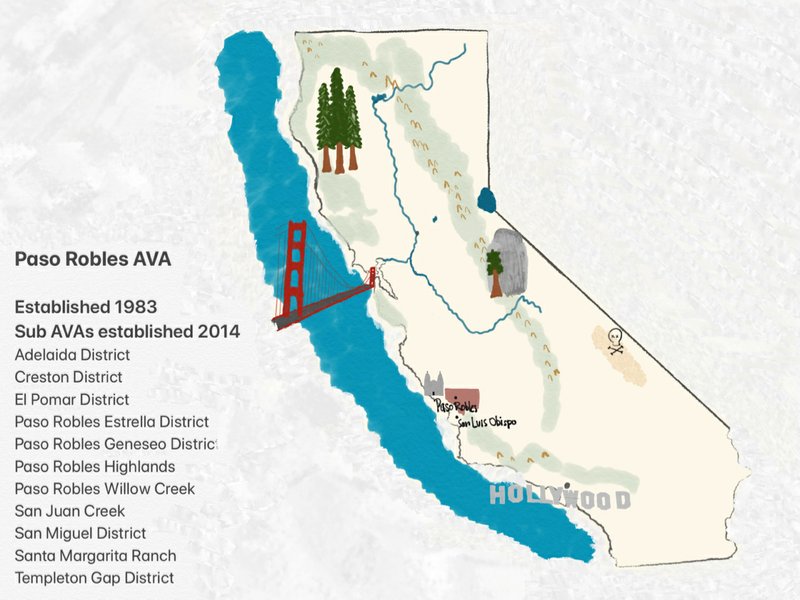Paso Robles in California's Central Coast is said to be the wild west of California wine. The town El Paso de Robles — which means "Pass of the Oak" — was founded by three men arriving in California in 1849 looking for gold: Brothers Daniel and James Blackburn from Virginia and Drury James from Kentucky (uncle to infamous outlaw Jesse James).
It's considered the wild west of wine not so much because of its connection with the Jameses, but because it is a wine region where many traditional rules are being broken by innovation, creativity and a region fortunate with diverse growing conditions.
The Paso Robles American Viticultural Area was founded in 1983 with a boundary almost three times the size of Napa Valley. In 2014, the region was divided into 11 sub AVAs giving unique distinction in each area's diversity of microclimates, soils and elevations. Because of the broad range of geological diversity, a vast range of grape varieties thrive. While the region can have summertime temperatures in excess of 100 degrees, it has a diurnal swing of an astounding 40 to 50 degrees with nighttime temperature drops. This swing preserves the grapes' acidity that is sometimes rare in warmer climate growing regions.
Grapevines were introduced to the area by Spanish conquistadors in the late 1700s. Today, there are more than 40,000 vineyard acres in Paso Robles with 200 plus wineries.
Even though the legacy of Paso Robles lies with the zinfandel grape, today more than 55% of all vines planted are devoted to cabernet sauvignon and Bordeaux blends (merlot, cabernet franc, petit verdot). Cabernet sauvignon thrives in this warm climate region and finds its unique expression in the diversity of the soils and elevations.
Paso Robles was given the nickname "Rhone Zone" because it has the largest acreage plantings of syrah, viognier and roussanne in California. Many other Rhone grapes are also being planted in this region. Italian grapes also contribute to the diversity of this agriculture haven. Vine cuttings from sangiovese, nebbiolo, barbera and montepulciano grapes were brought with Italian immigrants around the 1860s. Many of these grapes are found in blends and we are seeing more and more on retail shelves in our market.
The Values
2018 Peachy Canyon Incredible Red Zinfandel, California (about $13 retail)
2018 Estancia Paso Robles Cabernet Sauvignon, California (about $13 retail)
2018 Sean Minor Cabernet Sauvignon, California (about $14 retail)
The Splurges
2018 Ridge Lytton Springs Zinfandel, California (about $48 retail)
2017 J. Lohr Paso Robles Seven Oaks Cabernet Sauvignon, California (about $19 retail)
2018 Daou Paso Robles Cabernet Sauvignon, California (about $28 retail)
2018 Justin Paso Robles Cabernet Sauvignon, California (about $30 retail)
2018 Broadside Paso Robles Cabernet Sauvignon, California (about $18 retail)
2018 Daou Paso Robles Sauvignon Blanc, California (about $19 retail)
2017 Dueling Pistols Red Paso Robles, California (about $50 retail)
Lorri Hambuchen is a member of London's Institute of Wines and Spirits. Contact her at the Arkansas Democrat-Gazette, P.O. Box 2221, Little Rock, AR 72203, or email:
Food on 03/11/2020

